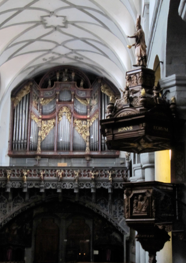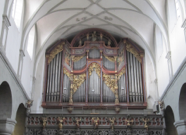St. Mary’s Cathedral
konstanzer münster cathedral
Baden-Württemberg
konstanz, GERMANY
europe
JANUARY 25, 2011


St. Mary’s Cathedral
konstanzer münster cathedral
Baden-Württemberg
konstanz, GERMANY
europe
JANUARY 25, 2011


The Cathedral of Constance, known in German as Konstanzer Münster, is affectionally known as St. Mary’s Cathedral or Unsere Lieben Frau or “Our Beloved Lady”. The twelve bells that peal in the tower the are heard across the Old Town of Konstanz. These bells were a gift of the state of Baden-Wurttenberg, the German province within which the city and this cathedral stand on the southwestern end of the Bodensee, Lake Constance. The cathedral, rich in history, is also rich in architecture, built over the centuries in a variety of styles including Romanesque, Gothic, and Baroque, with Neo-Gothic elements. Its central tower, where the bells are principally located, dominates the Alt Stadt and Münsterplatz where it stands 76 meters/ 250 feet high, a glowing beacon across the city at night. The Cathedral, dedicated to the Virgin Mary, dates to the 7th century, located on the Mintster Hill where a Romanesque fortification and adjoining civilian settlement was located. The Holy Sepulchre/St. Maurice’s Rotunda was built in 940. The cathedral collapsed in 1052 and was reconstructed with an eastern transept and three naves separated by 16 monoliths. Over the following three hundred years, two towers were built, then one was destroyed by fire along with parts of the basilica and 96 houses in the city. The south tower was completed in 1378. In the years between 1414 and 1418, the Council of Constance was held in Konstanz, the most important assembly of the Catholic Church during the Middle Ages, and the only one held on German soil. Martin V was elected pope by the Conclave, ending the schism dividing the church amongst three popes: Avignon, Pisa, and Rome. He was enthroned in this Minster in 1417. Between 1418 and 1425 the Minster was adapted to the Gothic style. Because of the reformation and the radical iconoclasm instigated by the Zurich reformer Huldrych Zwingli, who was ordained to his priesthood here in 1505, allowed much of the artwork in the cathedral to be taken or destroyed. In the interim, between 1526 and 1551, the Bishop left Konstanz and moved his See to Martinsburg in Meersburg, just across the Bodensee. In the centuries that followed, many of the artworks, wrought-iron gates and sculptures were replaced or repaired. In 1821 the Bishopric of Konstanz, the largest in Germany, was dissolved, and in 1827 it was moved to Freiburg to the Breisgau. The Catholic Church in the Konstanzer Münchner Cathedral had served the people around the Bodensee for twelve hundred years, lead by almost 100 bishops. Between 1844 and 1860, the cathedral was restored and the tower was built in a Neo-Gothic style. In 1955, Pope Pius XII raised the Minster to a papal Basilica Minor. The interior and exterior of the cathedral underwent a major restoration between 1962 and 2010, with only work on a stained glass window progressing on the day Henry and I visited the cathedral.
PHOTO: Left Column: 1. Konstanzer Münster Cathedral, also known as St. Mary’s Cathedral. 2. Detail: doors of the cathedral. Each of the 20 rectangular divisions depicts a scene from the life of Christ. C. 1470. 3. Carved wooden sculpture of Christ with crown of thorns. An altar of candles stands before him. Center, Top: View of the nave of the cathedral. Center, Middle: View of the central altar of the cathedral. Center, Bottom: The Gothic Welserkapelle, a 15th century chapel on the north side of the church. Right Column: 1. View of the beautifully carved wooden pulpit A special staircase of delicate ironwork leads to the pulpit. 2. Romanesque Madonna from the 13th century, a painted wooden sculpture of Unsere Lieben Frau. 3. Organ loft above the portal of the church c. 1680.


Unsere Lieben Frau - “Our Beloved Lady”







